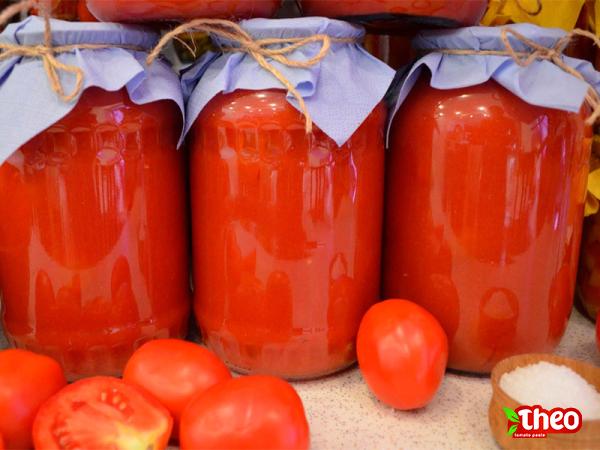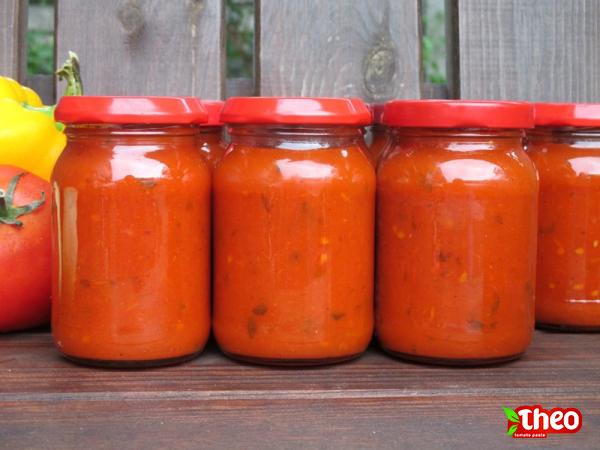Exploring the World’s Largest Paste Tomato Varieties Introduction: Paste tomatoes are a key ingredient in the culinary world, widely known for their rich flavor and high pulp content. These tomatoes are commonly used to make sauces, pastes, and purees due to their meaty texture and concentrated taste. In this article, we will delve into the world of the largest paste tomato varieties, uncovering their characteristics, cultivation tips, and potential applications in the food industry. 1. What are Paste Tomatoes? Paste tomatoes, also known as processing tomatoes, are a specific type of tomato cultivated for their higher amounts of solids, lower water content, and fewer seeds compared to other tomato varieties. Due to their thick and meaty flesh, they are ideal for cooking purposes, providing a more concentrated flavor. 2. The Importance of Paste Tomatoes in Food Industry: Paste tomatoes hold significant importance in the food industry, particularly in the production of tomato sauces, pastes, ketchup, and purees. Their sturdy texture and intense flavor make them an ideal choice for canning and preserving purposes. Chefs and home cooks alike value paste tomatoes for their ability to create rich, flavorful bases for a variety of dishes. 3. Characteristics of Largest Paste Tomato Varieties: Various tomato cultivars are known for their colossal size, making them stand out from regular-sized paste tomatoes. Some of the largest paste tomato varieties include:

tomato paste
 a. San Marzano: This Italian heirloom variety is widely recognized for its elongated shape, vibrant red color, and strong flavor. San Marzano tomatoes are sun-dried and used in various Italian dishes, providing a rich and sweet taste. b. Amish Paste: Known for its exceptional size and weight, the Amish Paste tomato is a popular choice among gardeners. Its robust flavor and firm, meaty texture make it perfect for canning or creating thick, delicious sauces. c. Giant Italian Paste: As its name suggests, this variety produces large, fleshy tomatoes that are perfect for making sauces and pastes. The Giant Italian Paste tomato showcases a sweet and tangy flavor, making it a preferred choice for homemade pasta sauces. d. Anna Russian: These pinkish-red paste tomatoes have a fruitier and more complex flavor compared to other varieties. They are known for their large size and excellent production, making them an attractive option for those seeking unique taste profiles. 4. Cultivation Tips for Largest Paste Tomato Varieties: Growing large paste tomatoes requires careful cultivation practices to ensure optimal yield and quality. Here are some tips to consider: a. Soil and Sunlight: Choose a well-draining, fertile soil location with at least six to eight hours of direct sunlight per day. Amend the soil with organic matter, such as compost or manure, to improve fertility. b. Planting: Start tomato seeds indoors 6-8 weeks before the last expected frost. Transplant the seedlings into larger pots and maintain a consistent temperature between 70-75°F (21-24°C). Harden off the plants before transplanting them into the garden. c. Support and Pruning: Use stakes, cages, or trellises to support the tomato plants and prevent sprawling. Prune the plants regularly, removing suckers and lower branches to promote air circulation and reduce the risk of diseases. d. Watering and Fertilizing: Provide consistent moisture to the plants, ensuring they receive around 1-1.5 inches of water per week. Fertilize with a balanced tomato fertilizer, following the package instructions to avoid overfeeding. e. Pest and Disease Management: Monitor the plants regularly for pests such as aphids, tomato hornworms, or whiteflies. Use organic pest control methods or consult with local garden experts to effectively manage any infestations. Practice crop rotation to minimize the risk of diseases like bacterial spot or early blight.
a. San Marzano: This Italian heirloom variety is widely recognized for its elongated shape, vibrant red color, and strong flavor. San Marzano tomatoes are sun-dried and used in various Italian dishes, providing a rich and sweet taste. b. Amish Paste: Known for its exceptional size and weight, the Amish Paste tomato is a popular choice among gardeners. Its robust flavor and firm, meaty texture make it perfect for canning or creating thick, delicious sauces. c. Giant Italian Paste: As its name suggests, this variety produces large, fleshy tomatoes that are perfect for making sauces and pastes. The Giant Italian Paste tomato showcases a sweet and tangy flavor, making it a preferred choice for homemade pasta sauces. d. Anna Russian: These pinkish-red paste tomatoes have a fruitier and more complex flavor compared to other varieties. They are known for their large size and excellent production, making them an attractive option for those seeking unique taste profiles. 4. Cultivation Tips for Largest Paste Tomato Varieties: Growing large paste tomatoes requires careful cultivation practices to ensure optimal yield and quality. Here are some tips to consider: a. Soil and Sunlight: Choose a well-draining, fertile soil location with at least six to eight hours of direct sunlight per day. Amend the soil with organic matter, such as compost or manure, to improve fertility. b. Planting: Start tomato seeds indoors 6-8 weeks before the last expected frost. Transplant the seedlings into larger pots and maintain a consistent temperature between 70-75°F (21-24°C). Harden off the plants before transplanting them into the garden. c. Support and Pruning: Use stakes, cages, or trellises to support the tomato plants and prevent sprawling. Prune the plants regularly, removing suckers and lower branches to promote air circulation and reduce the risk of diseases. d. Watering and Fertilizing: Provide consistent moisture to the plants, ensuring they receive around 1-1.5 inches of water per week. Fertilize with a balanced tomato fertilizer, following the package instructions to avoid overfeeding. e. Pest and Disease Management: Monitor the plants regularly for pests such as aphids, tomato hornworms, or whiteflies. Use organic pest control methods or consult with local garden experts to effectively manage any infestations. Practice crop rotation to minimize the risk of diseases like bacterial spot or early blight.
Specifications of tomato paste
 5. Applications in the Food Industry: The larger-sized paste tomatoes offer numerous culinary possibilities in the food industry. Their meaty texture and robust flavor make them an essential ingredient in various dishes, including: a. Tomato Sauce: The concentrated flavor and substantial texture of the largest paste tomatoes are perfect for creating mouth-watering tomato sauces. From traditional marinara to bolognese, the rich flavor and reduced cooking time make these tomatoes an ideal choice for sauces and gravies. b. Ketchup Production: Due to their superior tomato flavor and thick flesh, large paste tomatoes are often used in the production of ketchup. Their low water content ensures a rich, full-bodied sauce that complements a range of snacks and dishes. c. Tomato Paste: The dense nature of paste tomatoes makes them an excellent option for producing tomato paste. Tomato paste forms the base for various recipes, such as stews, chili, and other dishes that require concentrated tomato flavor. d. Purees and Soups: The high pulp content and meaty flesh of large paste tomatoes make them ideal for pureeing into creamy soups and smooth tomato-based sauces. Their deep flavor profile adds depth to soups and enhances the overall taste experience. Conclusion: The world’s largest paste tomato varieties offer gardeners and food enthusiasts a remarkable opportunity to explore the culinary potential of these flavorful tomatoes. With their robust taste, intense color, and concentrated texture, these tomatoes are highly sought after for making sauces, pastes, ketchup, and other tomato-based products. By following proper cultivation practices and understanding their various applications in the food industry, individuals can harness the true potential of these remarkable tomatoes in the realm of gastronomy.Exploring the Business Potential of the Largest Paste Tomato Varieties 1. Market Demand for Large Paste Tomatoes: The market demand for large paste tomatoes has been steadily increasing due to the growing popularity of homemade and artisanal food products. Consumers are increasingly seeking high-quality ingredients and unique flavors, making the largest paste tomato varieties an attractive option for both food enthusiasts and commercial businesses. 2. Farming and Distribution Opportunities: The cultivation of large paste tomatoes presents lucrative farming opportunities for both small-scale and large-scale farmers. By specializing in the production of these unique tomato varieties, farmers can cater to the specific demands of the food industry. Moreover, establishing a reliable distribution network is crucial to ensure that large paste tomatoes reach restaurants, food manufacturers, and retail outlets in a fresh and timely manner. 3. Value-Added Products and Brands: Entrepreneurs can take advantage of the large paste tomatoes’ distinct characteristics by developing value-added products and brands. This could include creating gourmet tomato sauces, artisanal ketchup, or premium-grade tomato paste. By highlighting the superior quality and attributes of these tomatoes, businesses can target discerning customers who are willing to pay a premium for exceptional taste and culinary experiences. 4. Collaborations with Restaurants and Chefs: Building partnerships with renowned restaurants and chefs can significantly boost the exposure and recognition of large paste tomato varieties. By featuring these tomatoes prominently on their menus, chefs can leverage their reputation and expertise to showcase the exceptional flavors and textures they offer. Supplying to high-end dining establishments can lead to increased demand, establishing a reputation as a trusted supplier of premium ingredients.
5. Applications in the Food Industry: The larger-sized paste tomatoes offer numerous culinary possibilities in the food industry. Their meaty texture and robust flavor make them an essential ingredient in various dishes, including: a. Tomato Sauce: The concentrated flavor and substantial texture of the largest paste tomatoes are perfect for creating mouth-watering tomato sauces. From traditional marinara to bolognese, the rich flavor and reduced cooking time make these tomatoes an ideal choice for sauces and gravies. b. Ketchup Production: Due to their superior tomato flavor and thick flesh, large paste tomatoes are often used in the production of ketchup. Their low water content ensures a rich, full-bodied sauce that complements a range of snacks and dishes. c. Tomato Paste: The dense nature of paste tomatoes makes them an excellent option for producing tomato paste. Tomato paste forms the base for various recipes, such as stews, chili, and other dishes that require concentrated tomato flavor. d. Purees and Soups: The high pulp content and meaty flesh of large paste tomatoes make them ideal for pureeing into creamy soups and smooth tomato-based sauces. Their deep flavor profile adds depth to soups and enhances the overall taste experience. Conclusion: The world’s largest paste tomato varieties offer gardeners and food enthusiasts a remarkable opportunity to explore the culinary potential of these flavorful tomatoes. With their robust taste, intense color, and concentrated texture, these tomatoes are highly sought after for making sauces, pastes, ketchup, and other tomato-based products. By following proper cultivation practices and understanding their various applications in the food industry, individuals can harness the true potential of these remarkable tomatoes in the realm of gastronomy.Exploring the Business Potential of the Largest Paste Tomato Varieties 1. Market Demand for Large Paste Tomatoes: The market demand for large paste tomatoes has been steadily increasing due to the growing popularity of homemade and artisanal food products. Consumers are increasingly seeking high-quality ingredients and unique flavors, making the largest paste tomato varieties an attractive option for both food enthusiasts and commercial businesses. 2. Farming and Distribution Opportunities: The cultivation of large paste tomatoes presents lucrative farming opportunities for both small-scale and large-scale farmers. By specializing in the production of these unique tomato varieties, farmers can cater to the specific demands of the food industry. Moreover, establishing a reliable distribution network is crucial to ensure that large paste tomatoes reach restaurants, food manufacturers, and retail outlets in a fresh and timely manner. 3. Value-Added Products and Brands: Entrepreneurs can take advantage of the large paste tomatoes’ distinct characteristics by developing value-added products and brands. This could include creating gourmet tomato sauces, artisanal ketchup, or premium-grade tomato paste. By highlighting the superior quality and attributes of these tomatoes, businesses can target discerning customers who are willing to pay a premium for exceptional taste and culinary experiences. 4. Collaborations with Restaurants and Chefs: Building partnerships with renowned restaurants and chefs can significantly boost the exposure and recognition of large paste tomato varieties. By featuring these tomatoes prominently on their menus, chefs can leverage their reputation and expertise to showcase the exceptional flavors and textures they offer. Supplying to high-end dining establishments can lead to increased demand, establishing a reputation as a trusted supplier of premium ingredients.
buy tomato paste
 5. Private Label Products for Retailers: Large paste tomatoes provide an opportunity for retailers to develop private label products. By offering their own branded tomato sauces, purees, and ketchup made from the largest paste tomato varieties, retailers can differentiate themselves in the market. This approach allows them to cater to consumers who appreciate unique flavors and ingredients. 6. Online Retail and Subscription Boxes: E-commerce platforms and subscription box services have become increasingly popular in recent years. Businesses can tap into this trend by selling large paste tomatoes directly to consumers. By offering convenient online ordering and delivery, customers can access these unique tomato varieties regardless of their location. Subscription box services can also provide an avenue to introduce consumers to different paste tomato varieties and recipes, enhancing their culinary experiences. 7. Vertical Farming and Controlled Environment Agriculture: With the rise of sustainable farming practices, vertical farming and controlled environment agriculture techniques offer innovative opportunities for cultivating large paste tomatoes. These methods allow for year-round production, regardless of geographic location and climate conditions. By implementing energy-efficient technologies and optimizing growing environments, businesses can ensure consistent supply and quality of the largest paste tomatoes. 8. Collaborative Farming and Community Supported Agriculture (CSA): Collaborative farming and CSA models provide a platform for farmers to work together in cultivating large paste tomatoes. By pooling resources, knowledge, and product varieties, farmers can establish a collective brand and reach a wider market. Community-supported agriculture programs can connect farmers directly with consumers who are passionate about supporting local agriculture and accessing fresh, high-quality produce. 9. Export Opportunities: Large paste tomato varieties that are unique to a particular region can present export opportunities. Particularly in regions known for their culinary heritage or specific tomato varieties, exporting these large paste tomatoes to international markets can introduce new flavors and culinary experiences to a global audience. Establishing partnerships with importers and distributors is crucial for successful international expansion. 10. Research and Development: Continuous research and development are key to unlocking the full potential of the largest paste tomato varieties. Scientists and horticulturists can work together to develop new cultivars with improved characteristics, such as disease resistance, higher yields, and enhanced flavors. Collaborative efforts between research institutions, seed companies, and farmers can drive innovation in the cultivation and utilization of large paste tomatoes. 11. Educational Programs and Culinary Tourism: Education and culinary tourism can play a significant role in promoting large paste tomato varieties. Establishing educational programs, workshops, and culinary events centered around these tomatoes can attract both local and international participants. By showcasing the versatility and unique qualities of these tomatoes, businesses can foster a deeper understanding and appreciation among consumers and industry professionals. 12. Sustainable Practices and Environmental Benefits: Large paste tomato cultivation can also align with sustainable farming practices, such as organic and regenerative farming methods. Emphasizing these sustainable practices and promoting the environmental benefits of large paste tomatoes can appeal to consumers who prioritize ethical and eco-conscious food choices. Businesses can leverage these practices to build a positive brand image and attract a niche market segment. Conclusion: The largest paste tomato varieties offer a wealth of business opportunities in the food industry, ranging from farming and distribution to value-added products and collaborations with culinary establishments. By focusing on quality, differentiation, and innovation, businesses can tap into the growing demand for unique flavors and premium ingredients. With strategic marketing, partnerships, and sustainable practices, the world’s largest paste tomato varieties can create a thriving and profitable niche in the culinary market.
5. Private Label Products for Retailers: Large paste tomatoes provide an opportunity for retailers to develop private label products. By offering their own branded tomato sauces, purees, and ketchup made from the largest paste tomato varieties, retailers can differentiate themselves in the market. This approach allows them to cater to consumers who appreciate unique flavors and ingredients. 6. Online Retail and Subscription Boxes: E-commerce platforms and subscription box services have become increasingly popular in recent years. Businesses can tap into this trend by selling large paste tomatoes directly to consumers. By offering convenient online ordering and delivery, customers can access these unique tomato varieties regardless of their location. Subscription box services can also provide an avenue to introduce consumers to different paste tomato varieties and recipes, enhancing their culinary experiences. 7. Vertical Farming and Controlled Environment Agriculture: With the rise of sustainable farming practices, vertical farming and controlled environment agriculture techniques offer innovative opportunities for cultivating large paste tomatoes. These methods allow for year-round production, regardless of geographic location and climate conditions. By implementing energy-efficient technologies and optimizing growing environments, businesses can ensure consistent supply and quality of the largest paste tomatoes. 8. Collaborative Farming and Community Supported Agriculture (CSA): Collaborative farming and CSA models provide a platform for farmers to work together in cultivating large paste tomatoes. By pooling resources, knowledge, and product varieties, farmers can establish a collective brand and reach a wider market. Community-supported agriculture programs can connect farmers directly with consumers who are passionate about supporting local agriculture and accessing fresh, high-quality produce. 9. Export Opportunities: Large paste tomato varieties that are unique to a particular region can present export opportunities. Particularly in regions known for their culinary heritage or specific tomato varieties, exporting these large paste tomatoes to international markets can introduce new flavors and culinary experiences to a global audience. Establishing partnerships with importers and distributors is crucial for successful international expansion. 10. Research and Development: Continuous research and development are key to unlocking the full potential of the largest paste tomato varieties. Scientists and horticulturists can work together to develop new cultivars with improved characteristics, such as disease resistance, higher yields, and enhanced flavors. Collaborative efforts between research institutions, seed companies, and farmers can drive innovation in the cultivation and utilization of large paste tomatoes. 11. Educational Programs and Culinary Tourism: Education and culinary tourism can play a significant role in promoting large paste tomato varieties. Establishing educational programs, workshops, and culinary events centered around these tomatoes can attract both local and international participants. By showcasing the versatility and unique qualities of these tomatoes, businesses can foster a deeper understanding and appreciation among consumers and industry professionals. 12. Sustainable Practices and Environmental Benefits: Large paste tomato cultivation can also align with sustainable farming practices, such as organic and regenerative farming methods. Emphasizing these sustainable practices and promoting the environmental benefits of large paste tomatoes can appeal to consumers who prioritize ethical and eco-conscious food choices. Businesses can leverage these practices to build a positive brand image and attract a niche market segment. Conclusion: The largest paste tomato varieties offer a wealth of business opportunities in the food industry, ranging from farming and distribution to value-added products and collaborations with culinary establishments. By focusing on quality, differentiation, and innovation, businesses can tap into the growing demand for unique flavors and premium ingredients. With strategic marketing, partnerships, and sustainable practices, the world’s largest paste tomato varieties can create a thriving and profitable niche in the culinary market.




